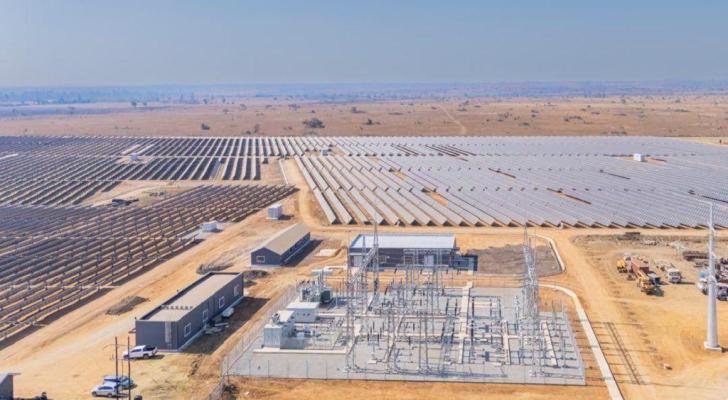News / National
Zimbabwe targets 2,100MW renewable energy by 2030
11 Nov 2024 at 07:03hrs |
0 Views

The Zimbabwean government has reaffirmed its commitment to advancing renewable energy solutions, aiming to achieve 1,100 megawatts (MW) from renewable energy sources by 2025 and 2,100 MW by 2030. These targets, set within the nation's Renewable Energy Policy, are intended to address Zimbabwe's longstanding electricity shortages and reduce dependency on traditional hydroelectric power, which has been impacted by erratic rainfall and climate change.
Speaking at the recent Africa Infrastructure and Built Environment Conference (AfriConfex) in Bulawayo, Finance, Economic Development, and Investment Promotion Minister, Professor Mthuli Ncube, through Chief Director Mr. Percy Takavarasha, highlighted Zimbabwe's current energy challenges. Power cuts have disrupted lives and economic activities, particularly as the Kariba Hydropower Station's capacity has been compromised by droughts and declining water levels.
"To mitigate these impacts, the government targets 1,100 MW by 2025 and 2,100 MW by 2030 from renewable energy and biofuels, including ethanol and biodiesel," Ncube said. The policy framework is a strategic approach to buffer consumers from power outages, promote clean energy, and meet future energy needs sustainably.
In support of this transition, the government is encouraging independent power producers (IPPs) through Government Implementation Agreements (GIA) that facilitate the setup of solar plants, with capacities ranging from 5KW for household use to 200KW for industrial applications. So far, several institutional and domestic biogas facilities have been installed, further promoting clean, renewable energy.
Professor Ncube emphasized Zimbabwe's extensive renewable energy resources - solar, wind, hydro, and geothermal - which are critical to reducing reliance on fossil fuels, creating jobs, and boosting economic growth. Collaborative efforts between the public and private sectors, he noted, are essential to driving investment in renewable energy infrastructure.
"Developing renewable energy can cut greenhouse gas emissions, provide job opportunities, and reduce poverty," he said. "It's about sustainable development that aligns with both our National Development Strategy (NDS1) and modernisation goals."
The Renewable Energy Policy (NREP) and the Biofuels Policy of Zimbabwe (BPZ), launched in March 2020, offer incentives to attract investors to the renewable energy sector. They also establish market mechanisms and regulatory frameworks that span solar, hydro, wind, geothermal, and biomass power. The Zimbabwe Energy Regulatory Authority (ZERA) has reported an increase in renewable energy projects, with cleaner energy sources expected to make up 27 percent of the country's power mix by 2030, up from 5 percent in 2017.
Beyond addressing immediate power shortages, the government envisions renewable energy as key to Zimbabwe's industrialization and economic stability. Under NDS1, reliable and low-cost energy access is central to ensuring sustained growth.
Meanwhile, Ncube addressed the urgent climate financing needs, estimating a funding gap of US$10.3 billion for climate adaptation and an additional US$4.8 billion for mitigation from 2023 to 2030. Bridging this gap, he added, will be crucial for Zimbabwe to meet its climate goals and achieve resilient energy infrastructure.
Speaking at the recent Africa Infrastructure and Built Environment Conference (AfriConfex) in Bulawayo, Finance, Economic Development, and Investment Promotion Minister, Professor Mthuli Ncube, through Chief Director Mr. Percy Takavarasha, highlighted Zimbabwe's current energy challenges. Power cuts have disrupted lives and economic activities, particularly as the Kariba Hydropower Station's capacity has been compromised by droughts and declining water levels.
"To mitigate these impacts, the government targets 1,100 MW by 2025 and 2,100 MW by 2030 from renewable energy and biofuels, including ethanol and biodiesel," Ncube said. The policy framework is a strategic approach to buffer consumers from power outages, promote clean energy, and meet future energy needs sustainably.
In support of this transition, the government is encouraging independent power producers (IPPs) through Government Implementation Agreements (GIA) that facilitate the setup of solar plants, with capacities ranging from 5KW for household use to 200KW for industrial applications. So far, several institutional and domestic biogas facilities have been installed, further promoting clean, renewable energy.
Professor Ncube emphasized Zimbabwe's extensive renewable energy resources - solar, wind, hydro, and geothermal - which are critical to reducing reliance on fossil fuels, creating jobs, and boosting economic growth. Collaborative efforts between the public and private sectors, he noted, are essential to driving investment in renewable energy infrastructure.
"Developing renewable energy can cut greenhouse gas emissions, provide job opportunities, and reduce poverty," he said. "It's about sustainable development that aligns with both our National Development Strategy (NDS1) and modernisation goals."
The Renewable Energy Policy (NREP) and the Biofuels Policy of Zimbabwe (BPZ), launched in March 2020, offer incentives to attract investors to the renewable energy sector. They also establish market mechanisms and regulatory frameworks that span solar, hydro, wind, geothermal, and biomass power. The Zimbabwe Energy Regulatory Authority (ZERA) has reported an increase in renewable energy projects, with cleaner energy sources expected to make up 27 percent of the country's power mix by 2030, up from 5 percent in 2017.
Beyond addressing immediate power shortages, the government envisions renewable energy as key to Zimbabwe's industrialization and economic stability. Under NDS1, reliable and low-cost energy access is central to ensuring sustained growth.
Meanwhile, Ncube addressed the urgent climate financing needs, estimating a funding gap of US$10.3 billion for climate adaptation and an additional US$4.8 billion for mitigation from 2023 to 2030. Bridging this gap, he added, will be crucial for Zimbabwe to meet its climate goals and achieve resilient energy infrastructure.
Source - The Herald
Join the discussion
Loading comments…



























